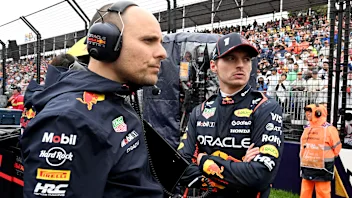Technical analysis - FRIC suspension systems explained
McLaren racing director Eric Boullier recently confirmed that the teams were sent a technical directive from the FIA's race director Charlie Whiting following the last race in Great Britain regarding the legality of the Front-and-Rear Interconnected Suspension (FRIC) systems used on most cars. The governing body is understood to believe that some of the systems currently being used may contravene the technical regulations, raising the possibility of them being banned outright. But what exactly is FRIC suspension and how does it work? Read on to find out…
Front-and-Rear Interconnected Suspension (FRIC) systems have been around for many years; for example Ferrari were one of several teams to run a cable-based system in the 1970s. However, the hydraulics-operated technology of today is much more complicated and can be ‘plumbed’ in many different ways - it can cross link the front suspension, cross link the rear suspension, link the front and rear suspension, or - in the most sophisticated systems - link all four corners diagonally for maximum performance benefit.
But why do so many teams use FRIC systems? The first and most important reason is that it can help to generate more underbody downforce as it gives a degree of control over how the car changes attitude at speed when downforce is increasing. It also allows some degree of ride height/rake control when the car is braking.
Formula One cars produce up to 6G of braking force which means that the load transfer from rear to front is around 300 kilos. This extra weight - there for around one second on corner approach - not only increases the load on the front tyres, it also decreases the load on the rear tyres, and this makes the rear unstable under braking and on corner entry.
The other problem with this weight transfer from a performance point of view is the aerodynamic changes that take place when the car changes attitude. The weight transfer causes the front of the car to get closer to the ground and the rear to get further away and, with normal aero-maps, this will increase front downforce and decrease rear downforce, adding to instability.
If you have a system - like FRIC - that can use the increased load on the front suspension under braking to lower the rear ride height then it is possible to have a much more aggressive underbody and front wing aero-map, which in turn increases the car’s overall downforce and therefore grip.
If the system is sophisticated enough to also allow fluid to be displaced diagonally across the car it also allows the car to be run with much softer suspension without the penalty of increased roll. Again, this will help with overall aerodynamic grip and allow the driver to be much more aggressive over the kerbs.
Most teams keep these sort of systems under wraps so it is difficult to define all the components in detail, but it general they consist of four actuators, one on each corner of the car (the locations of which are indicated by arrows 1 and 2 in this drawing of the 2013 Mercedes F1 W04), with hydraulic pipework connecting the four suspension units to a main accumulator (indicated by arrow 3) which is situated next to a control manifold (indicated by arrow 4).
The main accumulator and the valve system within it acts as the brains behind the system. However, the systems utilised by each team will vary considerably with regard to how they use the displaced hydraulic fluid from each actuator and whether they feed it through to another actuator either diagonally or inline.
In the rear detail image you can see two black actuators with the pipe work linking them to a central accumulator (indicated by the red arrow). As you can see in the main image, pipework then links this to the main accumulator.
In the front detail view (to the right of the main image) you can see the front two actuators inside the chassis (top two red arrows) with two pipes coming from them (middle pair of red arrows). These pipes are used to bleed and pressurise the system with dry break couplings (the lower pair of red arrows).
In the lower detail image, the forward two red arrows show the positioning of the main accumulator and control manifold linking the front and rear suspension, whilst the two rearward red arrows show the positioning of the right-rear actuator and central accumulator.
Next Up
Related Articles
 Norris collects World Championship trophy at FIA Awards
Norris collects World Championship trophy at FIA Awards Sainz hopes point-less finish in Abu Dhabi ‘serves as a wake-up call’
Sainz hopes point-less finish in Abu Dhabi ‘serves as a wake-up call’ Dr Helmut Marko to leave Red Bull motorsport advisor role
Dr Helmut Marko to leave Red Bull motorsport advisor role Russell calls his Abu Dhabi performance ‘dreadful’
Russell calls his Abu Dhabi performance ‘dreadful’ Verstappen pays tribute to Lambiase after ‘emotional year’
Verstappen pays tribute to Lambiase after ‘emotional year’ Piastri 'will be a world champion' in future – Norris
Piastri 'will be a world champion' in future – Norris